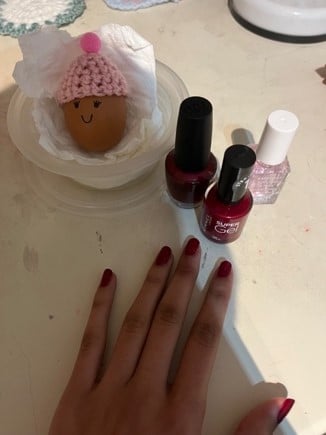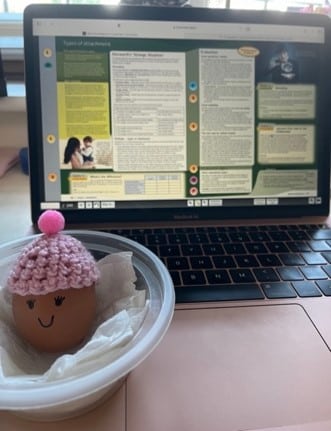Priya in Year 12 recently took part in the Egg Baby Project for her Psychology lesson. Priya had to look after the egg baby as you would a real child and not leaving the egg unattended. Take a look ay Priya’s responses on looking after her egg baby.
- Have you and your egg formed an attachment? How do you know?
I cared for my egg baby by making sure it was always safe and was never neglected/left alone. This caused an emotional tie between the egg baby and the caregiver (me) to form which lead to classic signs of attachment.
- Explain Schaffer and Emerson’s stages and Meltzoff (reciprocity and interactional synchrony) can be seen in your relationship with your egg baby.
Schaffer and Emerson proposed that there were four identifiable stages of attachment. The order of the stages are: asocial stage (behaviour towards humans and inanimate objects are fairly similar), indiscriminate attachment (more obvious and observable social behaviours), specific attachment (classic signs of attachment towards one person) and multiple attachments (secondary attachments). Meltzoff’s research found that there is a clear association between the behaviour of the adult model and the behaviour of the child. Later research found that interactional synchrony is innate. Initially, my egg baby showed signs that she slightly preferred to be around people rather than inanimate objects, but was still showing similar signs of behaviour towards inanimate objects and people. Later, she clearly showed signs of preference towards humans rather than inanimate objects and started showing classic signs of attachment.
- Which theory of attachment describes your bond that has formed? Learning theory? Bowlby? How did the attachment with your egg baby form according to these theories?
Bowlby’s theory describes the bond that has formed. An adaptive relationship has formed between the egg baby and the primary caregiver (me) because I have kept it safe and warm. A monotropic relationship is present between the egg baby and the primary caregiver (me).
- Mary Ainsworth identified 3 types of attachment. Which type of attachment do you believe exists between you and your egg baby? What behaviours does your egg show which identity this attachment type?
The 3 types of attachment are secure attachment, insecure-avoidant attachment and insecure-resistant attachment. Babies with secure attachment explore freely but regularly go back to their caregiver. Babies with insecure-avoidant attachment explore freely but do not seek proximity or show secure-base behaviour. Babies with insecure-resistant attachment seek greater proximity than others and so they explore less. I think my egg baby and I have a secure attachment because she showed proximity-seeking and secure-base behaviour. She showed moderate separation distress and moderate stranger anxiety too which suggests she can explore freely but always returns to ‘base’.
- According to Bowlby will your egg baby grow up to:
- Have healthy adult relationships? Why/why not?
Yes, because through the monotropic attachment (which has been formed), the egg baby will form an internal working model. The internal working model is a mental representation of our relationship with our primary caregiver that becomes a template for future relationships. Because the relationship between the egg baby and its primary caregiver (me) is healthy, all adult relationships should be healthy too.
7. Be a well-developed egg? How do you know?
Yes, because the egg baby and myself have formed an attachment during the critical period (between birth and 2 ½ years old). Also due to This means that she will be a well-developed egg.






